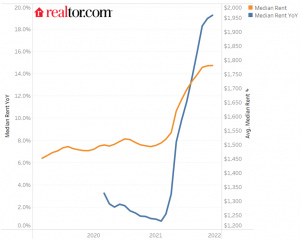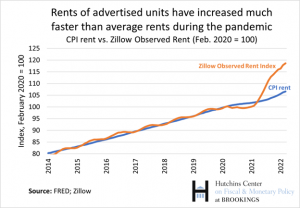Overview of US shelter inflation
Inflation has been one of the central talking points during 2021, and into 2022. What started as transitory inflation created by supply constraints, has proved to persist longer than expected initially. It continues to affect housing prices, which in turn pushes rents higher, increasing the cost of living for millions of families across the country.
Since the second quarter of 2020, shortly after the corona outbreak started, the median house sale price has increased ~33% to $428,700 as of the first quarter of 2022.
Source: FRED
This increase in house prices has also been reflected in rent price increases. Despite the policies taken, including the eviction moratorium, which caused a spike in evictions when it finally ended. Since 2021, the median rent has increased nearly 20%, and there seems to be no end in sight.

Source: Themreport
Shelter continues to be the biggest component of the CPI, representing about a third of the index, and also the main expense for most families. Despite the rent increases, this has not been fully reflected in the CPI numbers. In fact, the shelter component of the CPI has lagged the overall index.
The data shows that the increase in rent prices across Zillow listings has been higher than the current shelter inflation.

While house and rent price increases have not been fully priced into the CPI. This trend does not seem to stop here, as mortgage rates continue to increase driven by interest rate hikes. Although construction costs have also contributed to the increase in rent prices, they have started to decline, as a consequence of higher mortgage rates.
Is There a Link Between Inflation and Migration?
Perhaps one of the main drives of inflation, and in particular shelter inflation has been the migrants. But is this actually true? Could the inflow of new homebuyers explain the rapid increase in house and rent prices in certain areas of the country?
To understand whether there is a direct correlation between inflation and migration we need to analyze the following data points:
- Migration flow into Sun Belt metro areas
- Compare national average inflation with those regions
- Compare the average housing and rent prices with the Sun Belt metro areas
Migration inflow into Sun Belt metro areas
If we look closely at the cities with the largest population growth over the recent past, we see a correlation between them – they are all located in the Sun Belt region. In fact, the top 12 cities with the highest population growth are all located in Texas, Florida, Arizona, and Tennessee.
Florida and Texas in particular were the most popular states (around a 1% increase in the population of both states in 2021). A combination of attractive corporate conditions has also led several companies and their employees to move there.
This combined with the fact that certain cities in those states are seeing population growth above 5%, can explain the higher demand for housing, and therefore an increase in housing and rent prices in the area.
Compare national average inflation with those regions
The national average inflation measured by the CPI has been higher in both Texas and Florida. For example, Tampa is the city with the highest inflation rate in the country, at 11.3%, which is 30% higher than the average inflation in the US, followed closely by Phoenix and Atlanta.
This shows that the migration to these states seems to be having an effect on inflation.
Comparing the national average house and rent prices
Finally, when comparing the average increase in house and rent prices nationally with Sun Belt states we also see data that confirms that migration is driving higher inflation.
Out of the top 10 cities in the country with the highest rent increases, only New York was not located in the Sun Belt region. The same trend can be identified when analyzing the states and metro areas with the highest house price increases. Phoenix, Atlanta, Tampa, and Miami
Conclusion
Real estate investors have also been paying close attention to this, and that explains why Sun Belt Metros has slowly become the most attractive multifamily real estate markets in the country. In fact, in the first quarter of 2022 alone, the number of multifamily property transactions doubled compared to 2019.
This shows how the demand and supply in the multifamily real estate market have increased, and it is the most liquid in the country. Dallas, Phoenix, and Atlanta remain the most liquid multifamily real estate markets.
Migration in certain states has been a key contributor to inflation, and in particular in the rise of housing and rent prices. Sun Belt cities remain one of the most attractive destinations, and it seems like this trend will continue over the following years.
